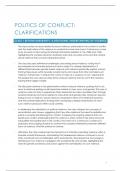Resume
Summary Politics of Conflict: Clarifications
- Cours
- Politics of Conflict
- Établissement
- Universiteit Gent (UGent)
this document contains solved exam questions, as well as a clear explanation of some concepts. Everything you need to pass the exam.
[Montrer plus]








